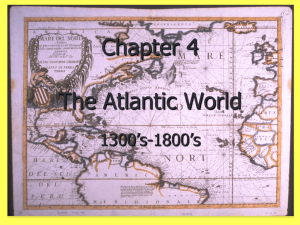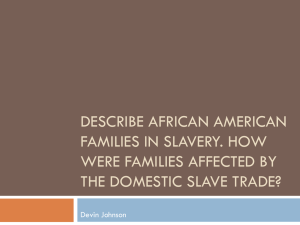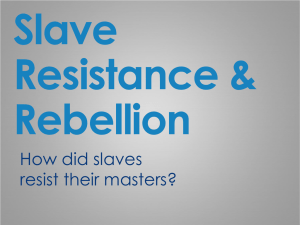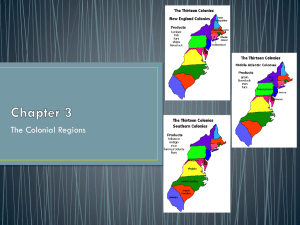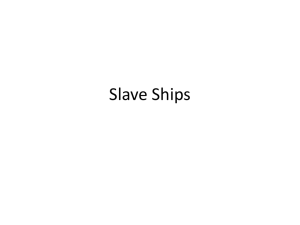Document
advertisement
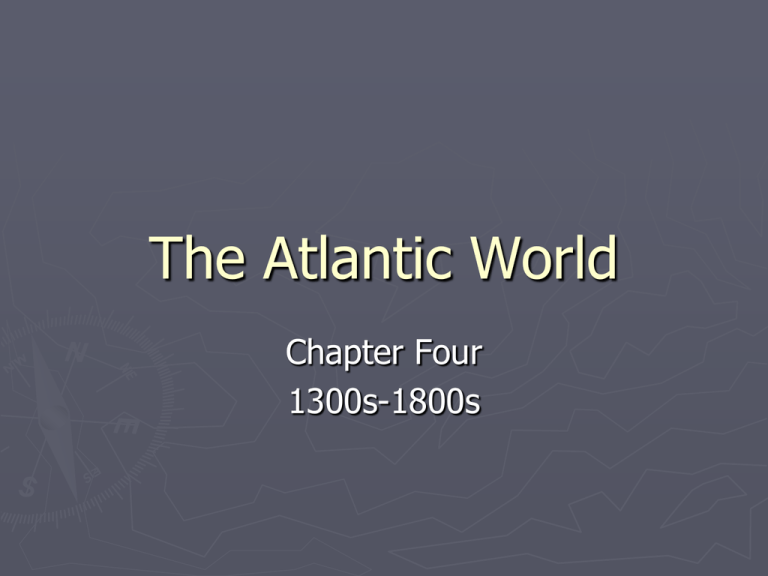
The Atlantic World Chapter Four 1300s-1800s The Age of Exploration ► What was the Age of Exploration? A time period when Europeans began to explore the rest of the world ► How was this possible? Improvements in mapmaking, shipbuilding, rigging, and navigation made long voyages possible ► Why do European countries explore? Policy of mercantilism drives exploration Finding new trade routes and trading “partners” were paramount What is mercantilism? ► Policy that stated there was a limited amount of money (gold and silver) in the world Each country needed to grab what they can before it is gone Export more than you import in order to create a favorable balance of trade ► Colonies and markets were needed to keep everything in the system Why did explorers explore? ► Many reasons Some reasons include: ►To find a sea route to the spices of Asia ►To find gold, silver, and precious stones ►To expand their knowledge of the world ►To control a larger empire ►To expand Christianity ►To find animal furs ►“Gold, God, and Glory!” The Explorers ► Portugal Vasco de Gama ►Landed in India in 1498 ►Established an important trade route from Europe to India and the East Indies Ferdinand Magellan ►His crew completed the first circumnavigation of the world in 1525 ►Magellan was killed in the Philippines Voyage of Vasco de Gama Magellan’s Voyage The Explorers ► Spain Christopher Columbus Believed he could reach the Indies faster by traveling west…found North America instead Established the Columbian Exchange ►A massive exchange of goods, plants, animals and diseases ►Exchange between New and Old Worlds Columbian Exchange The Struggle over the New World ► European countries fought for control of the New World and its natural resources ► New World provided for opportunities for great wealth ► Colonizing European powers: France England Spain Portugal Struggle Turns to Conflict ► England World wanted more land in the New First defeated the Dutch ► Dispute over lands in the Ohio Valley led to a war in 1754 This began the Seven Years’ War with France ►The battle in the New World was known as the French an Indian War The Conquistadors ► Spain Hernan Cortes in Mexico ► Able to defeat the mighty Aztec Empire ► Used superior weapons, allies, and disease ► 96% of the Aztec population died from 1500-1620 From 25 million to less than 1 million Cortes and the Aztecs ► Montezuma believed that Cortes was a god ► Invaded Aztec capital of Tenochtitlan in 1520 ► Was aided by Malinche a native woman translator The Conquistadors ► Francisco Pizzaro in Peru Arrived in South America in 1532 Defeated the Incan Empire (80,000 soldiers) Ambushed and kidnapped the Incan ruler Received a ransom then strangled and killed him anyway Pizzaro and the Inca ► Incan ruler was Atahualpa ► Spanish ambushed unarmed Incan soldiers and captured Atahualpa ► Pizarro was offered a room full of gold and silver, which he accepted ► The Spanish then strangled Atahualpa The Death of Atahualpa Francisco Pizzaro Europeans in North America ► 1524 - Italian Giovanni de Verrazano discovered New York Harbor ► 1607 -The English settle Jamestown in Virginia England’s 1st permanent settlement ► 1608 - Frenchman Samuel de Champlain founded “New France” Today it is Quebec ► 1609 - Henry Hudson finds the “Hudson River” Claims Manhattan Island for the Dutch The Atlantic Slave Trade ► Europeans needed slave labor in their colonies to grow crops, mine, etc. Native Americans were used, but many died due to disease ►Death rate due to disease was extremely high Africans replaced the Natives as the main source of slave labor for the Europeans ►Completely changed the trade relationship between Europe and Africa The Atlantic Slave Trade Timeline ► 1500-1600s Spain and Portugal began the trade ► 1600-1700s Slave Trade grows dramatically ► 1690 England increases the Slave Trade ► 1870 The Atlantic Slave Trade ends Atlantic Slave Trade Effects ► Begins a system of “Triangular Trade” Africa, Europe, and Americas all participate ► African rulers and traders made deals with Europeans for slaves Introduction of guns into African continent Western African economy and empires crumbled Slaves are transported through the “Middle Passage” Triangular Trade The Middle Passage The Middle Passage ► The Slave Ships The captain could be a “tight” or “loose” packer ► “Tight” meant slaves would be placed lying on each other ► Typically 20 percent or more Africans would die on the way to the New World ► Disease, malnutrition, beatings, suicide ► Once in the New World Slaves were auctioned of to the highest bidder This could easily separate families Slavery was a life-long condition, as well as hereditary The Middle Passage Slavery in the New World ► Slave Resistance Slaves tried to keep their cultural heritage Musical traditions Ancestral stories ► Slave Rebellion Often broke tools or worked slowly Many ran away Numerous revolts throughout the years The Growth of Global Trade ► Economic systems of Europe drastically changed ► Colonial empires that stretched through multiple continents led to a new business and trade practices Capitalism Joint-Stock Companies What is Capitalism? ► Economic system based on private ownership and the investment of resources, such as money, for profit Economic system where things are owned by people or an individual, not by a government ► Profits allow individuals and businesses to become extremely wealthy, not just the government What is a Joint-Stock Company? ►A business in which a number of investors combine their wealth for a common purpose Very similar to a modern-day corporation ► Early on in the 1500-1600s the purpose was colonization Overseas colonies were very expensive, but could be very profitable Changes in European Society ► Exploration and colonization led to an economic growth and boom in Europe Spurred the growth of towns and cities Rise of the merchant class with great wealth European nations became very wealthy ►Power monarchs increased greatly ► Majority of Europeans still remained poor and rural ► THE END
